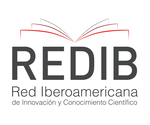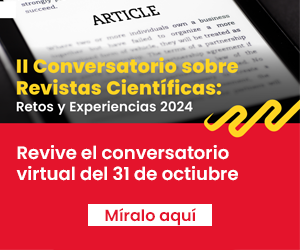Relación entre el nivel de ferritina y hemoglobina materna con los niveles de ferritina y hemoglobina de sus recién nacidos en un hospital público de Lima, Perú.
DOI:
https://doi.org/10.20453/rmh.v35i2.5019Palavras-chave:
Mujeres embarazadas, recién nacido, ferritinas, hemoglobinasResumo
Objetivo: Evaluar la relación entre los niveles de FS y Hb materna con los niveles de FS y Hb de sus RN. Material y métodos: Estudio correlacional. Incluyó gestantes a término, sin complicaciones y RN de parto eutócico. Fueron excluidos enfermedadeds crónicas, infecciones, hemoglobinopatias; RN de bajo peso y prematuridad. Se estimó una muestra al 95 % de confianza y 90 % de poder estadístico. Las gestantes fueron captadas consecutivamente. Se determinó FS por quimioluminiscencia y Hb por impedancia en sangre venosa materna y cordón umbilical del RN. Se consideró anemia materna: Hb<11g/dl, DH materno:FS<30ng/ml. Se realizó estadística descriptiva, r de Pearson o Spearman, T student y prueba de Suma de Rangos de Wilcoxon. Se consideró significativo p<0,05. Resultados: Incluimos 74 gestantes y sus RN. La edad materna fue 26 años (RIQ:22-31), edad gestacional 39,06±1,0 semanas. En 36,4 % se encontró anemia materna (leve o moderada en 96,3%), Hb ≥9g/dl en 94,6% y DH en 67,6%. Ningún RN presentó DH o anemia. La correlación global entre FS y Hb materna y del RN fue no significativa. Con FS materna <30ng/ml, la correlación fue significativa (r=0,339; p=0,01). No se encontró diferencia significativa entre las características antropométricas del RN de madres anémicas versus no anémicas. Conclusiones: No se encontraron correlaciones significativas para FS ni Hb materna con FS y Hb de sus RN, sin embargo, con un punto de corte de FS materna <30ng/ml, la correlación fue significativa. Amerita validar este punto de corte de FS para utilizarlo en el diagnóstico y monitoreo de la DH durante el embarazo.
Downloads
Referências
World Health Organization. Nutritional anaemias: tools for effective prevention and control. Geneva: World Health Organization. 2017.
Stevens GA, Finucane M, De-Regil L, Paciorek C, Flaxman, S, et al & Nutrition Impact Model Study Group. Global, regional, and national trends in haemoglobin concentration and prevalence of total and severe anaemia in children and pregnant and non-pregnant women for 1995–2011: a systematic analysis of population-representative data. The Lancet Global Health. 2013; 1(1):e16-e25.
Ministerio de Salud. Plan Nacional para la Reducción y Control de la Anemia Materno Infantil y la Desnutrición Crónica Infantil en el Perú: 2017-2021. Documento técnico del Ministerio de Salud. Lima: MINSA; 2017. Disponible en: https://bvs.minsa.gob.pe/local/MINSA/4189.pdf
Alcazar L. The economic impact of anemia in Peru. Lima: Grupo de análisis para el Desarrollo (Grade). 2013.
Kassebaum NJ. Th e global burden of anemia. Hematol Oncol Clin North Am.2016; 3(2):247–308.
WHO guideline on use of ferritin concentrations to assess iron status in individuals and populations. Geneva: World Health Organization. 2020.
American College of Obstetricians and Gynecologists. Anemia in pregnancy: ACOG practice bulletin, number 233. Obstet Gynecol. 2021; 138(2):e55-e64.
Ministerio de Salud. Norma Técnica de Salud para el manejo terapéutico y preventivo de la anemia en niños, adolescentes, mujeres gestantes y puérperas. Resolución Ministerial N° 250-2017/MINSA. Disponible en: https://cdn.www.gob.pe/uploads/document/file/322896/Norma_t%C3%A9cnica___Manejo_terap%C3%A9utico_y_preventivo_de_la_anemia_en_ni%C3%B1os__adolescentes__mujeres_gestantes_y_pu%C3%A9rperas20190621-17253-1wh8n0k.pdf?v=1561140238
Daru J, Zamora J, Fernández-Félix B, Vogel J, et al. Risk of maternal mortality in women with severe anemia during pregnancy and postpartum: a multilevel analysis Lancet Global Health. 2018; 6(5): e548-e554.
Figueiredo A, Gomes-Filho I, Silva R, Pereira P, Mata F, et al. maternal anemia and low birth weight: a systematic review meta-analysis. Nutrients. 2018; 10(5): 60.
Georgieff, M. K. Iron assessment to protect the developing brain. Am J Clin Nutr. 2017; 106(suppl-6):1588S-1593S.
Rice D, Barone S Jr. Critical periods of vulnerability for the developing nervous system: evidence from humans and animal models. Environ Health Perspect. 2000; 108(Suppl 3):511–33.
Markova V, Holm C, Pinborg A, Thomsen L, Moos T. Impairment of the developing human brain in iron deficiency: correlations to findings in experimental animals and prospects for early intervention therapy. Pharmaceuticals. 2019; 12(3):120.
Fisher AL, Nemeth E. Iron homeostasis during pregnancy. Am J Clin Nutr. 2017; 106(suppl-6):1567S-1574S.
Janbek J, Sarki M, Specht I, Heitmann B. A systematic literature review of the relation between iron status anemia in pregnancy and offspring neuro development. Eur J Clin Nutr. 2019; 73(12):1561-1578.
Sanni O, Chambers T, Li J, Rowe S, Woodman A, et al. A systematic reviewal and meta-analysis of the correlation between maternal and neonatal iron status and haematologic indices. E Clin Med 2020; 27:1-26.
Baker R, Greer F. Diagnosis and prevention of iron deficiency and iron-deficiency anemia in infants and young children (0–3 years of age). Pediatrics. 2010; 126(5):1040-1050.
Cabello EA, Hernández HR. Relación entre el nivel de ferritina y hemoglobina maternas con los niveles de ferritina y hemoglobina de sus recién nacidos en un hospital público de Lima, Perú [Tesis doctoral]. Lima: Universidad Peruana Cayetano Heredia; 2024. Disponible en: https://hdl.handle.net/20.500.12866/15235
Larsson S, Hillarp A, Hellström - Westas L, et al. When age really matters, ferritin reference intervals during infancy revisited. Scand J Clin Lab Invest. 2019; 79(8):590-594.
Lorenz L, Peter A, Poets C, Franz A. A review of cord blood concentrations of iron status parameters to define reference ranges for preterm infants. Neonatology. 2013;104(3):194-202.
Lalinde J, Castro E, Rodríguez J, Rangel J, Sierra C, et al. Sobre el uso adecuado del coeficiente de correlación de Pearson: definición, propiedades y suposiciones. AVFT. 2018; 37(5):587-595.
Paiva Ade A, Rondo PH, Pagliusi RA, Latorre Mdo R, Cardoso MA, Gondim SS. Relationship between the iron status of pregnant women and their newborns. Rev Saude Publica. 2007; 41(3):321–7.
Shao J, Lou J, Rao R, Georgieff M, Kaciroti N, et al. Maternal serum ferritin concentration is positively associated with newborn iron stores in women with low ferritin status in late pregnancy. J Nutr. 2012; 142(11):2004-2009.
Kakkar N, Aundhakar C. Effect of maternal anaemia on status of iron stores in neonates and anthropometry. Int J Health Sci. 2022; 6(S2): 295122961.
Basu, S, Kumar N, Srivastava R, Kumar A. Maternal and cord blood hepcidin concentrations in severe iron deficiency anemia. Pediatr. Neonatol. 2016; 57(5): 413-419.
Bothwell TH. Iron requirements in pregnancy and strategies to meet them. Am J Clin Nutr. 2000; 72:257S–64S.
Sangkhae V, Fisher A, Ganz T, Nemeth E. Iron Homeostasis During Pregnancy: Maternal, Placental, and Fetal Regulatory Mechanisms. Annu Rev Nutr. 2023; 43:279-300.
Santhakumar S, Athiyarath R, Cherian AG, Abraham V, George B, et al. Impact of maternal iron deficiency anemia on fetal iron status and placental iron transporters in human pregnancy. Blood Cells Mol Dis. 2023; 99:102727.
Zaman B, Rasool S, Jasim S, Abdulah D. Hepcidin as a diagnostic biomarker of iron deficiency anemia during pregnancy. J Matern Fetal Neonatal Med 2021; 34(8): 1288-1296.
O'Brien K, Zavaleta N, Abrams S, Caulfield L. Maternal iron status influences iron transfer to the fetus during the third trimester of pregnancy. Am J Clin Nutr. 2003; 77(4):924-930.
Cao C, O’Brien KO. Pregnancy and iron homeostasis: an update. Nutr Rev. 2013; 71:35–51.
Den Broek V, Letsky, Shenkin. Iron status in pregnant women: which measurements are valid? Br J Haematol.1998; 103(3): 817-824.
Daru J, Allotey J, Peña‐Rosas J, Khan K. Serum ferritin thresholds for the diagnosis of iron deficiency in pregnancy: a systematic review. Transfus Med. 2017; 27(3):167-174.
Rao, R, Tkac I, Schmidt A, Georgieff, M K. Fetal and neonatal iron deficiency causes volume loss and alters the neurochemical profile of the adult rat hippocampus. Nutr neurosci. 2011; 14(2): 59-65.
Tran P, Fretham S, Carlson E, Georgieff M. Long-term reduction of hippocampal brain-derived neurotrophic factor activity after fetal-neonatal iron deficiency in adult rats. Pediatr res.2009;65(5):493-498.
Basu S, Kumar D, Anupurba S, Verma A, Kumar A. Effect of maternal iron deficiency anemia on fetal neural development. J Perinatol.20218; 38(3):233-239.
Greminger A, Mayer-Pröschel, M. Identifying the threshold of iron deficiency in the central nervous system of the rat by the auditory brainstem response. ASN neuro.2015; 7(1):1759091415569911.
Pallone L, Jesus FA, Gonçalves G, Navarra L, Melo D, Ferreira R, Germano C.Effects of intrauterine latent iron deficiency on auditory neural maturation in full-term newborns. J. Pediatr. (Rio J.). 2020; 96:202-209.
Finkelstein J, O’Brien K, Abrams A, Zavaleta, N. Infant iron status affects iron absorption in Peruvian breastfed infants at 2 and 5 moth of age. Am J Clin Nutr. 2013; 98(6): 1475-1484.
El‐Farrash A, Ismail, EA, Nada AS. Cord blood iron profile and breast milk micronutrients in maternal iron deficiency anemia. Pediatr Blood Cancer. 2012;58(2):233-238.
Downloads
Publicado
Como Citar
Edição
Seção
Licença
Copyright (c) 2024 Emilio Andrés Cabello Morales, Herminio Renán Hernández Díaz

Este trabalho está licenciado sob uma licença Creative Commons Attribution 4.0 International License.
Os autores cedem os seus direitos à RMH para que estas possam divulgar o artigo através dos meios ao seu alcance. A revista fornecerá formulários de declaração de autoria e autorização para a publicação do artigo, que deverão ser entregues juntamente com o manuscrito. Os autores conservam o direito de partilhar, copiar, distribuir, executar e comunicar publicamente o seu artigo, ou parte dele, mencionando a publicação original na revista.



















